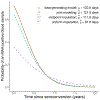Regression with interval-censored covariates: Application to cross-sectional incidence estimation
- PMID: 33866544
- PMCID: PMC9363237
- DOI: 10.1111/biom.13472
Regression with interval-censored covariates: Application to cross-sectional incidence estimation
Abstract
A method for generalized linear regression with interval-censored covariates is described, extending previous approaches. A scenario is considered in which an interval-censored covariate of interest is defined as a function of other variables. Instead of directly modeling the distribution of the interval-censored covariate of interest, the distributions of the variables which determine that covariate are modeled, and the distribution of the covariate of interest is inferred indirectly. This approach leads to an estimation procedure using the Expectation-Maximization (EM) algorithm. The performance of this approach is compared to two alternative approaches, one in which the censoring interval midpoints are used as estimates of the censored covariate values, and another in which the censored values are multiply imputed using uniform distributions over the censoring intervals. A simulation framework is constructed to assess these methods' accuracies across a range of scenarios. The proposed approach is found to have less bias than midpoint analysis and uniform imputation, at the cost of small increases in standard error.
Keywords: EM algorithm; HIV/AIDS; cross-sectional incidence estimation; interval-censored covariates; joint modeling.
© 2021 The International Biometric Society.
Figures


References
-
- Brookmeyer R (1997) Accounting for Follow-up Bias in Estimation of Human Immunodeficiency Virus Incidence Rates. Journal of the Royal Statistical Society: Series A, 160, 127–140.
-
- Brookmeyer R (2010) On the statistical accuracy of biomarker assays for HIV incidence. Journal of Acquired Immune Deficiency Syndrome, 54, 406–414. - PubMed
-
- Brookmeyer R and Quinn T (1995) Estimation of current human immunodeficiency virus incidence rates from a cross-sectional survey using early diagnostic tests. American Journal of Epidemiology, 141, 166–172. - PubMed
-
- Busch MP, Pilcher CD, Mastro TD, Kaldor J, Vercauteren G, Rodriguez W, et al. (2010) Beyond detuning: 10 years of progress and new challenges in the development and application of assays for HIV incidence estimation. AIDS, 24, 2763–2771. - PubMed
Publication types
MeSH terms
Grants and funding
LinkOut - more resources
Full Text Sources
Other Literature Sources

